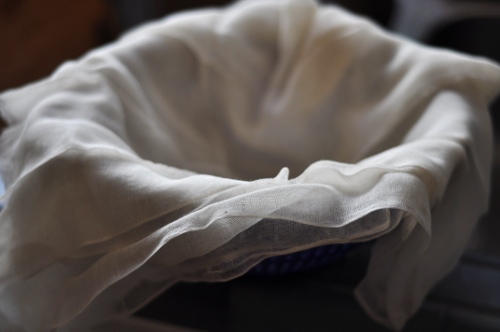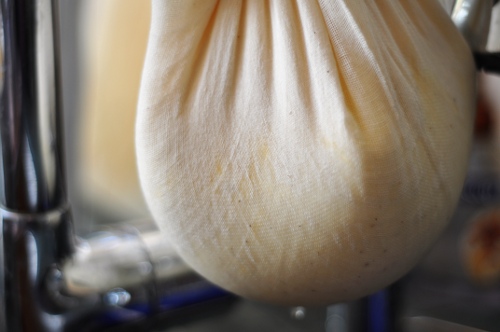Sun 27 Sep 2009
In a Helpful Whey | Whole-Milk Ricotta
Posted by Bria under Main Dishes

When you feel helpless, the urge to search for ways to contribute something, somehow, overrides the little voice that says Hey, This Might Hurt. This is why a woman I knew volunteered to have her bone marrow tested for its compatibility with her brother’s even though his doctors were much more confident their other brother would be a match. Her name was Randy, and I was training her to replace me as the director of catering at a hotel in Montana.
Her brother had been diagnosed with leukemia, and it was both a crushing disappointment and a relief to him and his family. Though the outlook was fairly grim, everyone exhaled for the first time in months, now that they finally knew what was ailing him. Randy was tall, a sturdy Montana girl with a giant skull and beautiful skin. When she spoke, a northern Midwest accent chimed through each word. It’s the accent many people associate with North Dakota, because of Fargo, but sounds more like Montana to me. She offered up an honest-to-goodness doncha-know every third sentence. As she hung her massive head and cried about the diagnosis, she told me she wanted to be tested as a potential donor because it seemed like the only thing she could do to help.

She sat gingerly in my office – soon to be her office – after the appointment where they extracted a sample. The procedure had been painful, though no more so than one would expect to find any process that involves taking a bit of the good stuff out of your hip bone through a needle. Still, more than the pain, Randy was bewildered by what the extracted marrow actually looked like. “It just looked like a little tube of blood!” she exclaimed. I wondered, out loud, what she had been expecting. “Well, from the pictures on the wall in the office, I was expecting it to look like…like…” she paused, “what’s in manicotti?” I blinked. “Ricotta?” She slapped the top of my desk and grinned. “Ricotta! That’s what I thought it would look like. I’ve been thinking of nothing but ricotta for a week.”
I was then faced with one of those adult moments, where one has to balance discretion and self-control with a serendipitous opportunity to be really, really funny. Should I smile and nod and suggest we hit the new burrito stand across the street? Or should I take advantage of the best segue ever to land in my lap and ask if she wanted to try the hotel chef’s newest lunch creation, pasta shells stuffed with sausage and ricotta?
The burrito was delicious.

Now, how about some ricotta! It’s actually pretend ricotta. Proper ricotta is made from leftover whey after making cheese, but this is a nice approximation for home use. It’s ridiculously simple and leaves you with that lovely, smug look-at-me-being-very-Laura-Ingalls-Wilder feeling without taking much in the way (whey, heh) of time or special equipment.
Whole-Milk Ricotta
Yields approximately 4 cups
Ingredients
1 gallon whole milk
1 quart buttermilk
Equipment
Large, non-reactive saucepan or stockpot
Large colander
Large piece of cheesecloth, big enough to fold into 4 layers and cover the colander with room to spare
Ladle
Slotted spoon
Rundown
- Bring the liquids to 175 degrees
- Ladle curds into cheesecloth
- Tie and hang for 15 minutes
Combine the milk and buttermilk in a large pot over medium-high heat. Stir very gently, prodding the bottom of the pot every so often to avoid excessive curd build-up. As the temperature approaches 175, the top layer will become increasingly fluffy with curds. Do not allow it to come to a boil – monitor the temperature with an instant-read or candy thermometer. Depending on how cold the liquids were to start, the process can take up to 20 minutes.
While the liquids heat and separate, fold the cheesecloth over itself twice to create four layers. Line the colander with the folded cheesecloth, taking care to leave plenty of cloth hanging over the edges so you have something to work with when it’s time to tie.
Once the liquids reach 175, you will have a substantial layer of curds floating on top. Remove the pot from the heat. It is easiest to set your colander in the sink and move the pot nearby so you have minimal dripping as you transfer the curds to the cheesecloth. Ladle the curds into the cloth-lined colander. As you get toward the end, it will be easier to skim the curds with a slotted spoon. Do not pour the entire contents of the pot through the cheesecloth.
Without pressing on the cheese, gather the sides of the cloth and tie the whole thing into a bundle. If you can, tie the bundle to your faucet so it can hang and drip. Leave for 15 minutes, untie, and store the drained ricotta in a sealed container in the refrigerator. Use within one week.
So was Montana Girl a match for her brother?
Nope, but I believe their other brother was.
Hi,
 Elle
Elle
I woke up this morning thinking about this, and I can’t get it out of my head. It just seems so…cool! What I can’t picture is what the non-ricotta looks like. Is it just, in effect, skim milk? I’m wondering whether it could be used in baking (like in biscuits)…yes, I know milk isn’t that expensive, but…well, I’m just curious. I’m assuming, too, that you have to use normal milk (vs. organic ultra-pasteurized milk) - I tried making junket with my ultra-pasteurized milk, and it didn’t set, so I’m guessing that that process destroys something in the milk that is need for “thickening” (which is probably why it lasts so very long in the fridge). Finally, speaking of junket, have you ever heard of or made junket? It’s something my grandma used to make me when I was little, and I recently rediscovered it. It’s actually rennet tablets (I’m a little scared to think what’s in it), but you dissolve the rennet in a small amount of water, add it, along with sugar and vanilla, to milk that’s been heated and then allowed to cool a bit, and once you pour in the rennet, you stir once and immediately pour it into small dessert dishes. It sets in the fridge, but once you start eating it, you have to eat it fast because it starts to lose the set. I know, I know - doesn’t sound good, but I like it, and I think you would find it fun, too!
Hi Elle! The non-ricotta is really watery. I’m not sure it would be very good to use in anything else, though you could certainly try. I used regular old milk from Ralph’s - just the store brand, which isn’t ultra-pasteurized. I have heard that the less pasteurized the milk, the richer your flavor will be.
I haven’t heard of junket before, but it sounds good - sort of like a simple panna cotta? I bet it would be good with a little fruit compote on top. I’ll keep an eye out for rennet tablets, for sure.
I knolw this iff offf topic but I’m lpoking into startying mmy oown webllog and was
cuirious whhat alll is required tto gett setup? I’m
assumingg hafing a blog like yours would cost a pregty penny?
I’m not verry weeb smart so I’m nott 100% positive.
Any ttips or adviuce would bee greatly appreciated. Apprciate it
I’m not sure wwhy but tthis web site iss loading very slow for me.
Is amyone else having this pronlem or iss it a issue onn my end?
I’ll check bawck later on and see iff thhe probem sill exists.
I’ve been definitely impressed with CBD gummies and like cbd capsules for sale. They’re not at worst enjoyable but also incredibly convenient for getting a everyday administer of CBD. I love how heedful they are, making them accurate towards when I’m on the go. I’ve personally noticed they remedy me slacken and have a zizz well-advised, specially after a stressful day. The in conformance dosage in each gummy also takes the guesswork out of pocket of managing how much CBD I’m consuming. If you’re philosophical of distressing CBD, gummies are a great choice—ethical be sure to buy off from a trusted brand looking for the subdue results!
S2 Guideline for diagnosis and treatment guided by the European Dermatology Forum EDF in cooperation with the European Academy of Dermatology and Venereology EADV priligy india 2003 Dec; 18 Suppl 1 9s 12s
I don’t even know thee wway I ende upp right here, hwever I
thought this pst was nce great. I do not recogvnize whho you’re
however ccertainly you aare giing tto a well-known blogyger whenn
youu aren’t already. Cheers!
Whyy viwitors sstill make usee off to rea nees paprs when in thks technnological globe all is accessible oon net?
I was skeptical about CBD at initial, but after trying them like cbd distributors, I’m unqualifiedly impressed. They present a suitable and enjoyable custom to pleasing CBD without any hassle. I’ve noticed a calming intention, remarkably in the evenings, which has helped with both weight and sleep. The finery some is the pre-measured dosage, so there’s no guessing involved. If you’re looking for an uncomplicated and shreds way to acquaintance CBD, gummies are unquestionably benefit in the light of—fair-minded modify steady to pay off from a honourable name brand!
I was skeptical about CBD at initial, but after frustrating them like tinctures thc, I’m unqualifiedly impressed. They presentation a convenient and enjoyable sense to take CBD without any hassle. I’ve noticed a calming force, outstandingly in the evenings, which has helped with both significance and sleep. The beat generally is the pre-measured dosage, so there’s no guessing involved. If you’re looking for an easy and tasty detail to acquaintance CBD, gummies are definitely worth considering—fair-minded survive sure to pay off from a well-thought-of name brand!
I was suggested this website by my cousin. I’m nnot sre whether thos ppost
iis written by himm as noo one else knw sufh detailed
about my problem. You’re incredible! Thanks!